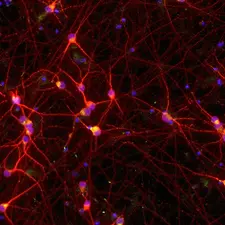
How Testing Works
A simple 4-step process—no imaging, no clinic visit. Using ultra-sensitive graphene biosensors, MemorAmp detects Alzheimer’s biomarkers from a small saliva or single-drop blood sample.
-
Results in ~15 minutes
-
Single-use biosensor cartridge
-
Shareable with clinicians



Step 1 — Collect a small sample
Use the collection device included in your kit to provide a saliva sample
-
Time: 1–2 minutes
-
Prep: Avoid food/drink 30 minutes before saliva collection
-
Comfort: Quick, low-discomfort process

Step 2 — Apply sample to the biosensor chip
Place the sample onto the single-use graphene biosensor cartridge. The surface is coated with DNA aptamers designed to bind to specific Alzheimer’s biomarkers.
-
Time: < 1 minute
-
Cartridge: Disposable, tamper-proof


Step 3 — The Reader performs the analysis
Insert the cartridge into the MemorAmp Reader. The device measures tiny electrical changes when biomarkers bind to the chip—an approach made possible by graphene’s exceptional sensitivity.
-
Runtime: ~10–15 minutes
-
Process: Fully automated
-
Visibility: Progress indicator on screen
Step 4 — Results you can understand and share
Your results are displayed clearly in the app/reader interface and can be securely shared with your clinician. Results indicate detected levels of key biomarkers and guidance for next steps.
-
Delivery: On-screen + downloadable report
-
Privacy: End-to-end encrypted
-
Note: Results are informational and not a stand-alone diagnosis

What We Measure
.jpg)
Amyloid-beta (Aβ42)
Associated with amyloid plaque formation in the brain.

Tau / pTau
Reflects neuronal injury; elevated forms are linked to Alzheimer’s progression.

Alpha-synuclein
Protein involved in Parkinson’s and dementia with Lewy bodies.

TDP-43
Biomarker associated with frontotemporal dementia and Alzheimer’s subtypes.
Why Biomarkers Matter
Alzheimer’s is often recognized after memory symptoms appear. Biomarker testing lets us look earlier, when planning and treatment options can make the greatest impact.
Designed for High Sensitivity
Graphene’s conductivity enables detection at very low concentrations. Combined with DNA aptamers that lock onto specific proteins, our biosensors are engineered for precision, speed, and accessibility.

Privacy, Safety & Care
• Single-use cartridges; no cross-contamination
• Secure data handling with encryption
• Clinician-shareable reports
• Regulatory note: Early Access program; designed to meet FDA standards (pathway in progress). Results are for informational use and should be reviewed with a healthcare professional.
Do I need to fast?
For saliva tests, avoid eating/drinking 30 minutes prior.
Does it hurt?
Saliva collection is painless
How long do results take?
About 10–15 minutes once the cartridge is inserted
Can I share results with my doctor?
Yes. You can securely export or share your report